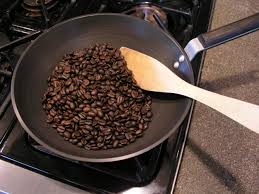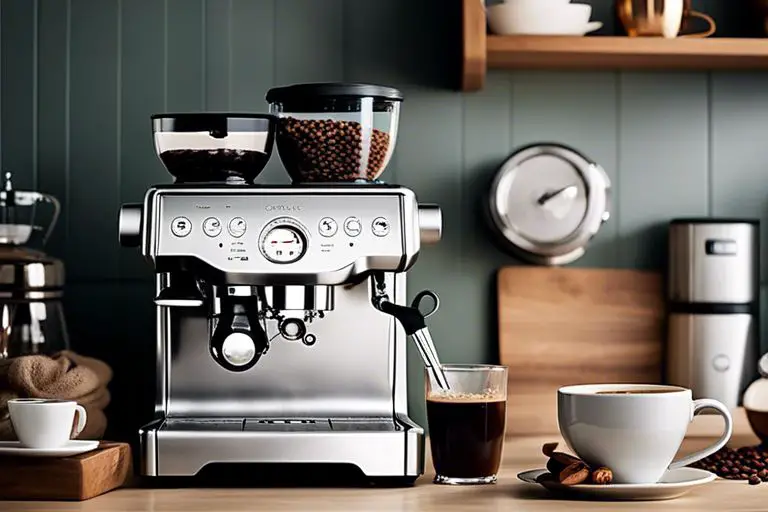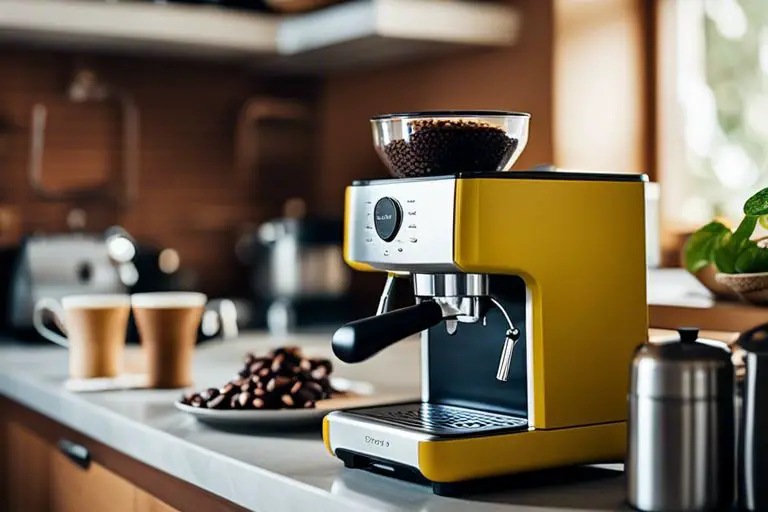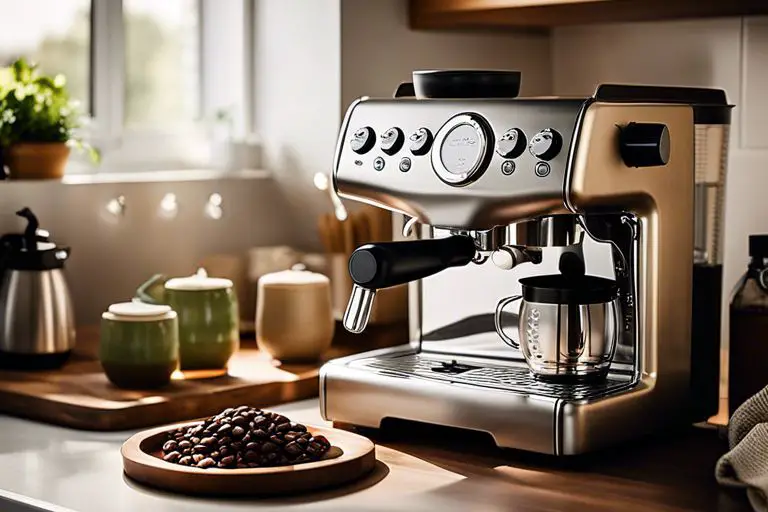Learning how to roast coffee beans is about timing, temperature and using the right device to produce the freshest most delicious coffee you have ever tasted. Roasting coffee in the oven at home enables you to tailor each cup of coffee to your exact requirements.
This article discusses the best techniques and methods for home coffee roasting by looking at what professional coffee roasters do and then taking elements of that and replicating it in a home environment.
Professional coffee roasters have tens if not hundreds of thousands of pounds worth of equipment because they are producing large volumes of coffee beans to distribute to all their customers.
What they don’t tell you is that the techniques they use can be done at home for a small cost or for nothing at all using equipment you already have in the kitchen.
Why roast your own coffee? You can buy roasted coffee beans in the local supermarket or online in many different varieties and different strengths so why bother doing it yourself?
Roast it exactly how you like it
A lot of the coffee beans you find in the supermarket are a dark roast and have a lot of the flavour roasted out of them because the quality of the beans are not great and they are intended for espresso-based drinks such as latte or cappuccino.
When you buy roasted beans you have to accept them the way they are. They are already roasted and ready to grind.
When you roast yourself you can adapt the colour of the beans by roasting them longer or shorter so they turn the exact shade of brown to suit your own individual coffee taste.
For a milder tasting coffee you can reduce the roasting time for a light brown colour.
Slightly longer and you’ll get a medium roast and a darker brown for a stronger, deeper coffee flavour.
Roast them longer still and you will get a deep dark brown colour for the strongest coffee flavour perfect for espresso.
Different roast levels are also suitable for different brewing methods. A lighter roast is more suitable for filter coffee machines or cafetière and a darker roast more suitable for espresso.
This article explains more about the different shades of roasted coffee beans:
With a little bit of practice and trial and error, you can tweak the roast time so that you get the exact colour you want so you can have your coffee exactly how you like it.
Coffee is a very personal thing and you may love a certain coffee that someone else doesn’t and the other way round.
When you buy roasted coffee beans the roaster has tried to accommodate what most people will like but you can make it how you like it.
Roasting coffee at home is fun
If you drink coffee every day then why not turn it into a bit of a hobby? The great thing about it is that you can do a batch at the weekend and it will last you the whole week or longer.
Over time you will learn to perfect your technique and it feels good to have made something you already enjoy even better by getting more involved in the process of making your own coffee.
You get to learn something new and you get better coffee at the end of it. It’s also not something that is not going to consume a lot of your time.
Once you’ve cracked it you’ll be able to roast a batch in under 30 minutes from start to finish and during the learning phase an hour or two at the weekend or when you have some spare time is all you need.
Better value for money
Buying unroasted green coffee beans removes a part of the process before it gets to you (the roasting part) so you will get more for less and better quality as well.
These are a good example of a good quality green coffee bean ready for roasting:
Green Coffee Beans from Santos Brazil
They are 100% Arabica coffee beans that are hand-harvested from coffee trees grown in the shade. To get the best out of them a medium roast is recommended.
You can expect to pay a lot more for fully roasted coffee beans of the same quality.
As fresh as it gets
The fresher coffee is the better it tastes and a lot of the time you don’t know how fresh it is because you don’t know the roasting date.
Good coffee will have the date it was roasted on the pack but if it doesn’t then it could easily have been roasted months ago.
If you drink coffee more than about 4 weeks after the date it was roasted then the flavour will be affected and you are not getting the best out of it.
What better way to know the roasting date than by doing it yourself? After roasting it needs to be left for a few days to rest and then you can drink it at its peak every time.
What do you need to roast coffee at home?
One of the best things about roasting your own coffee beans is that you don’t need to spend a lot of money to get started and you can actually get away without spending any extra money at all if you don’t want to.
There are very few things you need:
Coffee beans
Buy some unroasted green coffee beans as described above and you are good to go.
There is zero preparation required, they are literally ready to be roasted straight out of the packet.
Unroasted green coffee beans do go through a process after they have been picked such as washing and drying but that will already have been done before they get to you.
If you want to learn more about coffee before it becomes coffee beans these articles are a good resource:
Is coffee a fruit and can you eat it?
Does coffee grow on a plant or a tree?
Home coffee roasting methods
If you have a kitchen then you are pretty much good to go. This article is directed mainly at anyone that wants to try roasting coffee at home cheaply.
You can spend hundreds or even thousands of pounds on a home coffee roaster but if you go down that road you are looking at a major investment in something that you don’t even know if it’s something you want to be doing over the long term.
If you are just getting started there are other ways that will cost you from zero to about £50.
There are a number of different ways to roast coffee at home, some better than others but you can try out most of them for little to no cost so our recommendation is to try a few and see which one you get on with the best and go from there.
Coffee roasting machine
A machine that is specifically made for roasting coffee beans will require little to no learning as it is made specifically for one purpose only.
Each machine differs slightly but essentially you choose the temperature you want the beans to roast at and how long you want to roast them for and the machine does the rest.
If you don’t mind spending the money then it’s the easiest way to get good results but its not very much fun and not recommended for beginners because if you decide it’s not for you then you have wasted your money.
Try one of the other methods first and if you like what you produce then you can consider a dedicated coffee roasting machine later.
Roasting coffee with a popcorn machine
If you already have a popcorn machine then you can give it a go but we definitely would not recommend buying a popcorn machine for the specific purpose of roasting coffee beans.
They are low cost but you’re not going to get very good results. You can’t control the temperature and on many there is no timer so you’ll need to keep an eye on them to make sure they are not burning.
Roasting coffee in a pan
You may already have a cast iron pan or a heavy base grill pan in your cupboard.
One of those and a whisk is all you need. We would recommend using about 200 grams to 300 grams of coffee beans to start with depending on how big your pan is.
When you pour the beans in make sure they are spread out so that there is approximately one layer of beans evenly spread across the entire pan as spaced out as possible.
What you don’t want is to have a mound of beans all piled up on top of each other otherwise they will roast unevenly.
Use a medium heat and roast in the pan for anywhere between 10 – 17 minutes for a medium to dark roast.
Timings will vary depending on the country of origin, the size of the beans and the level of roast that you enjoy.
The most important thing is to keep an eye on the colour of the beans at all times.
Light brown is a lightly roasted bean and should be achieved in about 7-8 minutes.
Medium brown is a medium roast in about 10 minutes and dark brown for a dark roast in about 15 minutes.
If you have an espresso machine then lean towards medium to dark roast and if you use a filter coffee machine or a cafetière or an Aeropress then aim for a light to medium roast.
After about 5 minutes you will start to hear the beans pop like popcorn. This is called the “first crack”. This happens when all of the moisture is removed from the beans during the heating process and a signal that you are getting towards the halfway point for a good medium roast.
Stir with a whisk throughout the entire time the beans are in the pan to make sure each bean is roasted all over and as evenly as possible.
It can be a bit smoky but this is normal so just make you have the ventilation on the cooker hood on if you have one to suck up the smoke that gets released.
What you are looking for is for all the beans to be the same colour or very similar.
Keep stirring and agitating so that all the beans get the same amount of heat applied to them.
It will take a few goes to get used to it and to start with lean towards fewer beans as that will give you the best chance to get an even roast across all the beans.
Coffee beans also have a “second crack” which you know is happening because you’ll hear the sound like popcorn popping for a second time.
This starts to occur as the beans are moving from a medium to a dark roast and personally this is the exact time that I remove them from the heat because if you let them all go to the second crack then you can lose some of the best flavour.
Once they reach a nice medium brown colour take them straight off the heat and pour them into a large sieve.
You want to cool them down as quickly as possible and stop them from roasting so give them a good toss and a shake for about 2-4 minutes to help them cool down.
After that just keep them in a cool place out of direct sunlight for about 48 hours to allow them to settle and then you are ready to brew your very own roasted coffee beans.
This is a good video showing this method in action:
A ceramic coffee roaster
This is a really good halfway house between spending a lot of money on a coffee roasting machine and roasting them in a pan.
The design ensures an even roast as the hot air gets circulated inside the bowl creating an even heat across all the beans.
All you need to do is take it out of the oven every 3 minutes and give it a shake which I have found creates a very even roast.
It’s super easy to use as well. Just place about 250g of unroasted beans in the oven at 240 degrees Celcius and roast for approximately 6 minutes for a light roast, 10 minutes for medium and 12-15 for a dark roast.
After a few goes you will find what’s right for you.
This is a good option if you want to go down the road of a ceramic coffee roaster:
It’s a brilliant gift as well if you know someone that loves coffee but they have never roasted their own beans before.
Nuovo ceramic coffee bean roaster
Roasting coffee on a baking tray in the oven
This method won’t cost you a penny. Just place some beans on a baking tray on top of some greaseproof paper in a pre-heated oven at 240 degrees Celcius and roast as described above for the ceramic coffee roaster.
You won’t get as even a roast but it’s a way of roasting your own beans without spending any money.
Should you roast your own coffee beans?
If you love coffee and you have never tried it before then it’s a fun way to enhance your coffee drinking experience.
You can save money and create a bespoke coffee exactly how you like it and you’ll certainly never drink a fresher cup of coffee.






